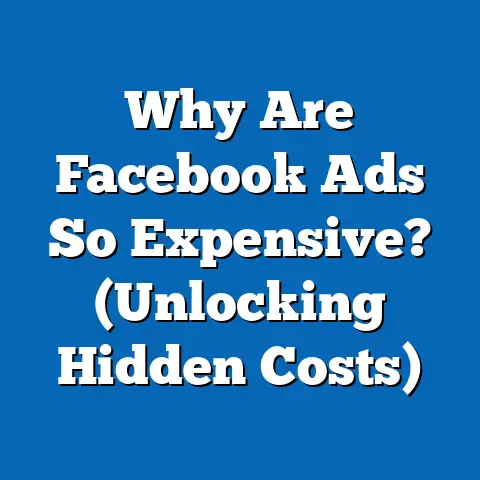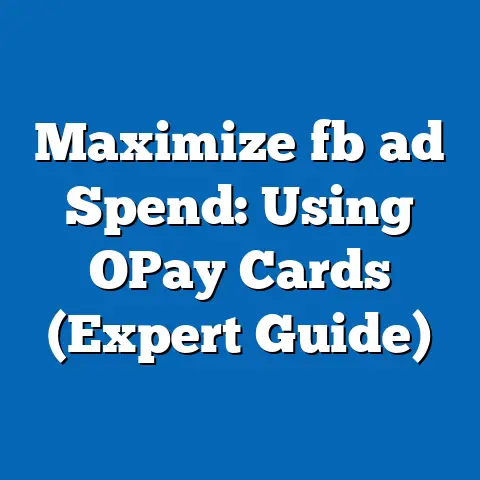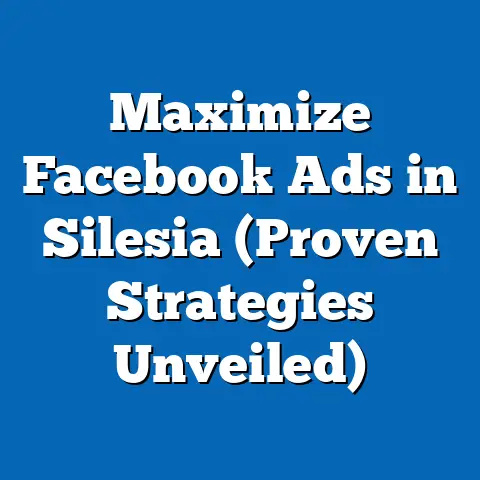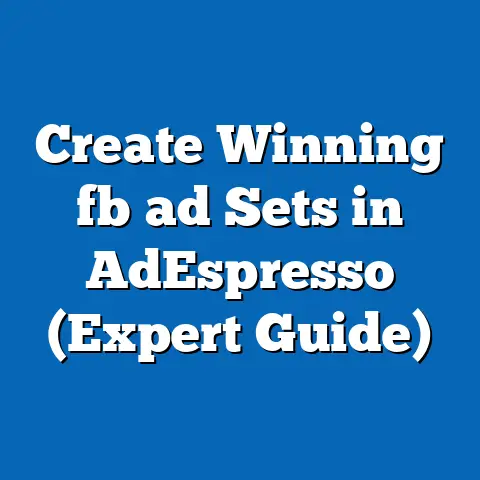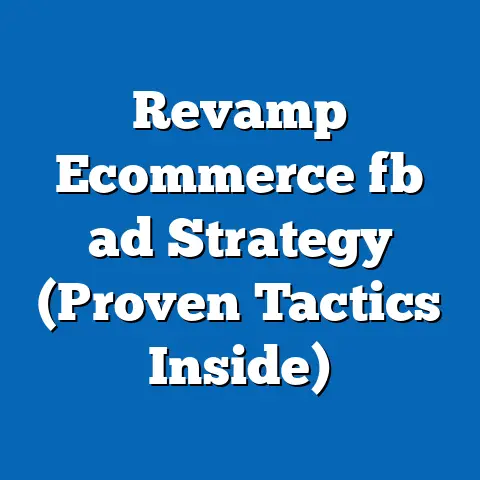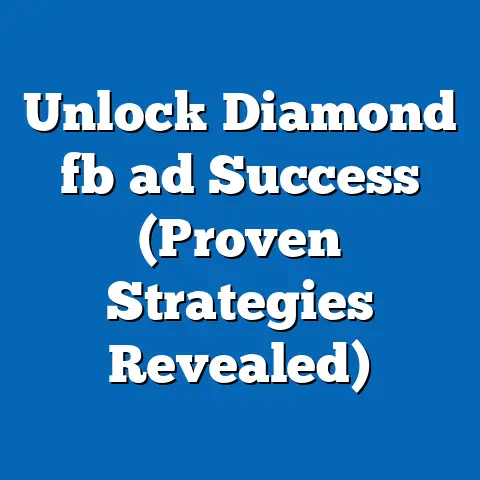Unveiling Facebook Ads Costs (Insightful Price Breakdown)
Facebook advertising. It’s a phrase that can either excite or intimidate you, depending on your familiarity with the platform. I’ve been navigating the world of Facebook ads for years, and I can tell you, it’s a constantly evolving landscape. What remains constant, however, is the importance of understanding the costs involved.
Think about it. You have a fantastic product, a compelling service, and a burning desire to reach your target audience. Facebook, with its billions of users, seems like the perfect place to connect. But throwing money at ads without understanding the underlying cost structure is like sailing a ship without a rudder. You might end up anywhere – and likely, nowhere good for your business.
That’s why I’m diving deep into the world of Facebook ads costs. This isn’t just about throwing numbers at you; it’s about providing an insightful price breakdown that empowers you to make informed decisions, optimize your campaigns, and ultimately, achieve a higher return on your investment.
Consider this: in 2023, global digital ad spending reached a staggering $626.86 billion, with social media ads accounting for a significant chunk. Facebook, as a dominant player, captures a substantial portion of this market. This means more businesses are vying for attention on the platform, making it even more critical to understand how costs are determined and how to maximize your budget.
Overview of Facebook Ads
Facebook ads are more than just pretty pictures and catchy slogans. They are a sophisticated system designed to connect businesses with their ideal customers. But before we delve into the costs, let’s establish a foundation by understanding what Facebook ads are and what they can do for your business.
At its core, Facebook advertising allows you to target specific demographics, interests, behaviors, and even connections of your audience. This level of granularity is what sets Facebook apart from traditional advertising methods. You’re not just broadcasting your message to the masses; you’re delivering it to the people most likely to be interested in what you have to offer.
Facebook offers a variety of ad formats to cater to different campaign objectives. Here’s a quick rundown:
- Image Ads: Simple yet effective, these ads feature a single image with accompanying text and a call-to-action. They are great for showcasing products or services visually and driving traffic to your website.
- Video Ads: Captivating and engaging, video ads allow you to tell your story in a dynamic way. They are ideal for brand awareness, product demonstrations, and generating leads.
- Carousel Ads: Showcase multiple products or features in a single ad unit. Each card in the carousel can have its own image, description, and link, making it perfect for e-commerce businesses.
- Slideshow Ads: Create a video-like experience using a series of still images. They are a cost-effective way to create engaging content without the need for expensive video production.
- Collection Ads: Designed for mobile shoppers, collection ads feature a hero image or video followed by a grid of product images. They offer a seamless shopping experience within the Facebook app.
The unique selling proposition of Facebook as an advertising platform lies in its powerful algorithm, extensive targeting options, and robust user engagement metrics. The algorithm, driven by machine learning, constantly learns and adapts to user behavior, ensuring that your ads are shown to the right people at the right time. The targeting options allow you to pinpoint your ideal customer based on a plethora of factors, including demographics, interests, behaviors, and even custom audiences based on your own customer data. And finally, the user engagement metrics provide valuable insights into how your ads are performing, allowing you to optimize your campaigns for maximum impact.
Factors Influencing Facebook Ads Costs
Now that we’ve established a basic understanding of Facebook ads, let’s dive into the factors that influence their cost. Understanding these factors is crucial for effectively managing your budget and maximizing your ROI.
-
Bidding Strategy: Your bidding strategy plays a significant role in determining the cost of your ads. Facebook offers two primary bidding options: automatic and manual. With automatic bidding, Facebook automatically sets your bids to get you the most results for your budget. This option is ideal for beginners who want a hands-off approach. Manual bidding, on the other hand, gives you more control over your bids. You set the maximum amount you’re willing to pay for each click or impression. This option is suitable for experienced advertisers who want to optimize their campaigns for specific goals.
- Automatic Bidding: Facebook dynamically adjusts your bids based on real-time auction data to achieve your desired results within your budget. This is great for simplicity but can sometimes lead to higher costs if the algorithm is trying to reach a highly competitive audience.
- Manual Bidding: Allows you to set your own maximum bid. This offers more control but requires a deep understanding of the auction dynamics. For instance, if you’re targeting a very competitive niche, your manual bid might need to be higher than you initially anticipate.
-
Ad Quality and Relevance Score: Facebook rewards high-quality, relevant ads with lower costs and better performance. Your ad’s relevance score, a metric from 1 to 10, reflects how well your ad resonates with your target audience. A higher relevance score translates to lower costs and increased reach. I’ve seen firsthand how improving ad quality can drastically reduce costs. By focusing on creating engaging, informative, and relevant content, you can significantly improve your relevance score and lower your ad spend.
- Importance of Quality Content: Think about what resonates with your audience. Are they interested in discounts, informative content, or engaging stories? Tailor your ad copy and visuals to match their preferences.
- Relevance Score Impact: A high relevance score can significantly reduce your cost per click (CPC) and increase your ad’s visibility.
-
Target Audience: The size and specificity of your target audience directly impact your ad costs. A broad audience may seem appealing, but it can lead to wasted ad spend if your ads are shown to people who are not interested in your product or service. A highly specific audience, on the other hand, can be more expensive to reach, but it can also lead to higher conversion rates.
- Audience Size Matters: Larger audiences can lead to lower CPMs (cost per thousand impressions) but might also result in lower conversion rates.
- Demographic and Geographic Targeting: Targeting specific demographics (age, gender, location) can increase costs, especially in densely populated or affluent areas. For example, targeting millennials in New York City will likely be more expensive than targeting the same demographic in a smaller town.
-
Ad Placement: Where your ads appear on Facebook and its network also influences their cost. Different placements, such as the Facebook News Feed, Instagram Feed, Audience Network, and Messenger, have varying costs and performance. The Facebook News Feed is generally the most expensive placement, but it also tends to deliver the best results. The Audience Network, which includes third-party apps and websites, is typically the least expensive, but it may not be as effective for all types of campaigns.
- News Feed vs. Right Column: Ads in the News Feed generally have higher engagement and conversion rates, leading to higher costs. Right column ads are often cheaper but less effective.
- Instagram and Audience Network: Instagram ads can be effective for visual products, while the Audience Network can provide cost-effective reach.
-
Competition: The level of competition within the advertising space for specific audiences or keywords can significantly impact your ad costs. If you’re targeting a highly competitive audience or using popular keywords, you can expect to pay more for your ads. To mitigate this, consider targeting niche audiences or using long-tail keywords that are less competitive. For example, if you’re selling running shoes, instead of targeting “running shoes,” try targeting “trail running shoes for women.”
- Seasonal Fluctuations: Costs tend to increase during peak seasons like holidays and major shopping events due to higher competition.
- Industry-Specific Competition: Some industries, like finance and insurance, are inherently more competitive, leading to higher advertising costs.
Bidding Strategy: Your bidding strategy plays a significant role in determining the cost of your ads. Facebook offers two primary bidding options: automatic and manual. With automatic bidding, Facebook automatically sets your bids to get you the most results for your budget. This option is ideal for beginners who want a hands-off approach. Manual bidding, on the other hand, gives you more control over your bids. You set the maximum amount you’re willing to pay for each click or impression. This option is suitable for experienced advertisers who want to optimize their campaigns for specific goals.
- Automatic Bidding: Facebook dynamically adjusts your bids based on real-time auction data to achieve your desired results within your budget. This is great for simplicity but can sometimes lead to higher costs if the algorithm is trying to reach a highly competitive audience.
- Manual Bidding: Allows you to set your own maximum bid. This offers more control but requires a deep understanding of the auction dynamics. For instance, if you’re targeting a very competitive niche, your manual bid might need to be higher than you initially anticipate.
Ad Quality and Relevance Score: Facebook rewards high-quality, relevant ads with lower costs and better performance. Your ad’s relevance score, a metric from 1 to 10, reflects how well your ad resonates with your target audience. A higher relevance score translates to lower costs and increased reach. I’ve seen firsthand how improving ad quality can drastically reduce costs. By focusing on creating engaging, informative, and relevant content, you can significantly improve your relevance score and lower your ad spend.
- Importance of Quality Content: Think about what resonates with your audience. Are they interested in discounts, informative content, or engaging stories? Tailor your ad copy and visuals to match their preferences.
- Relevance Score Impact: A high relevance score can significantly reduce your cost per click (CPC) and increase your ad’s visibility.
Target Audience: The size and specificity of your target audience directly impact your ad costs. A broad audience may seem appealing, but it can lead to wasted ad spend if your ads are shown to people who are not interested in your product or service. A highly specific audience, on the other hand, can be more expensive to reach, but it can also lead to higher conversion rates.
- Audience Size Matters: Larger audiences can lead to lower CPMs (cost per thousand impressions) but might also result in lower conversion rates.
- Demographic and Geographic Targeting: Targeting specific demographics (age, gender, location) can increase costs, especially in densely populated or affluent areas. For example, targeting millennials in New York City will likely be more expensive than targeting the same demographic in a smaller town.
Ad Placement: Where your ads appear on Facebook and its network also influences their cost. Different placements, such as the Facebook News Feed, Instagram Feed, Audience Network, and Messenger, have varying costs and performance. The Facebook News Feed is generally the most expensive placement, but it also tends to deliver the best results. The Audience Network, which includes third-party apps and websites, is typically the least expensive, but it may not be as effective for all types of campaigns.
- News Feed vs. Right Column: Ads in the News Feed generally have higher engagement and conversion rates, leading to higher costs. Right column ads are often cheaper but less effective.
- Instagram and Audience Network: Instagram ads can be effective for visual products, while the Audience Network can provide cost-effective reach.
Competition: The level of competition within the advertising space for specific audiences or keywords can significantly impact your ad costs. If you’re targeting a highly competitive audience or using popular keywords, you can expect to pay more for your ads. To mitigate this, consider targeting niche audiences or using long-tail keywords that are less competitive. For example, if you’re selling running shoes, instead of targeting “running shoes,” try targeting “trail running shoes for women.”
- Seasonal Fluctuations: Costs tend to increase during peak seasons like holidays and major shopping events due to higher competition.
- Industry-Specific Competition: Some industries, like finance and insurance, are inherently more competitive, leading to higher advertising costs.
Key Takeaway: Understanding these factors empowers you to strategically manage your Facebook ad spend. By optimizing your bidding strategy, improving ad quality, refining your target audience, and carefully selecting ad placements, you can significantly reduce your costs and improve your ROI.
Cost Breakdown by Campaign Objectives
Facebook offers a variety of campaign objectives designed to help you achieve specific business goals. Each objective has its own cost structure, depending on the factors we discussed earlier. Let’s take a closer look at the cost breakdown for some of the most common campaign objectives.
-
Brand Awareness: The primary goal of brand awareness campaigns is to increase the visibility of your brand and reach a wider audience. These campaigns typically focus on impressions, which means you pay for every thousand times your ad is shown (CPM). The average CPM for brand awareness campaigns can vary significantly by industry, but it generally falls between \$5 and \$15.
- CPM Variations: Industries with high competition, such as finance and insurance, tend to have higher CPMs.
- Campaign Goal: The goal is to maximize reach and frequency, so focus on optimizing your ads for impressions rather than clicks or conversions.
-
Lead Generation: Lead generation campaigns aim to collect contact information from potential customers. These campaigns typically focus on cost per lead (CPL), which is the amount you pay for each lead you generate. The average CPL can range from \$10 to \$50, depending on the industry, target audience, and ad quality.
- CPL Factors: Ad quality, landing page optimization, and the value proposition of your offer significantly impact CPL.
- Example: Offering a free e-book or a discount code in exchange for contact information can be an effective lead generation strategy.
-
Conversions: Conversion campaigns are designed to drive specific actions on your website, such as purchases, sign-ups, or form submissions. These campaigns typically focus on cost per acquisition (CPA), which is the amount you pay for each conversion. The average CPA can vary widely depending on the product or service you’re offering, but it generally ranges from \$20 to \$100 or more.
- CPA Influencers: Product price, website conversion rate, and ad targeting accuracy heavily influence CPA.
- Optimization: Continuously test different ad creatives, landing pages, and targeting options to optimize for the lowest possible CPA.
-
Engagement: Engagement campaigns aim to increase likes, shares, comments, and other forms of engagement on your Facebook posts. These campaigns typically focus on cost per engagement (CPE), which is the amount you pay for each interaction. The average CPE can range from \$0.01 to \$0.10, depending on the ad quality and target audience.
- Engagement Benefits: Increased engagement can lead to higher organic reach and brand visibility.
- Content Strategy: Create engaging content that encourages interaction, such as polls, quizzes, and contests.
Brand Awareness: The primary goal of brand awareness campaigns is to increase the visibility of your brand and reach a wider audience. These campaigns typically focus on impressions, which means you pay for every thousand times your ad is shown (CPM). The average CPM for brand awareness campaigns can vary significantly by industry, but it generally falls between \$5 and \$15.
- CPM Variations: Industries with high competition, such as finance and insurance, tend to have higher CPMs.
- Campaign Goal: The goal is to maximize reach and frequency, so focus on optimizing your ads for impressions rather than clicks or conversions.
Lead Generation: Lead generation campaigns aim to collect contact information from potential customers. These campaigns typically focus on cost per lead (CPL), which is the amount you pay for each lead you generate. The average CPL can range from \$10 to \$50, depending on the industry, target audience, and ad quality.
- CPL Factors: Ad quality, landing page optimization, and the value proposition of your offer significantly impact CPL.
- Example: Offering a free e-book or a discount code in exchange for contact information can be an effective lead generation strategy.
Conversions: Conversion campaigns are designed to drive specific actions on your website, such as purchases, sign-ups, or form submissions. These campaigns typically focus on cost per acquisition (CPA), which is the amount you pay for each conversion. The average CPA can vary widely depending on the product or service you’re offering, but it generally ranges from \$20 to \$100 or more.
- CPA Influencers: Product price, website conversion rate, and ad targeting accuracy heavily influence CPA.
- Optimization: Continuously test different ad creatives, landing pages, and targeting options to optimize for the lowest possible CPA.
Engagement: Engagement campaigns aim to increase likes, shares, comments, and other forms of engagement on your Facebook posts. These campaigns typically focus on cost per engagement (CPE), which is the amount you pay for each interaction. The average CPE can range from \$0.01 to \$0.10, depending on the ad quality and target audience.
- Engagement Benefits: Increased engagement can lead to higher organic reach and brand visibility.
- Content Strategy: Create engaging content that encourages interaction, such as polls, quizzes, and contests.
Key Takeaway: Understanding the cost structure for each campaign objective allows you to allocate your budget effectively and optimize your campaigns for maximum impact. By focusing on the right metrics and continuously testing and refining your ads, you can achieve your desired results at the lowest possible cost.
Average Costs and Budgeting for Facebook Ads
So, what are the average costs you can expect to pay for Facebook ads? As we’ve discussed, costs vary depending on a multitude of factors. However, let’s look at some general benchmarks to give you a starting point.
-
CPM (Cost Per Mille/Thousand Impressions): As of 2023, the average CPM across all industries is around \$10-\$15. However, this can fluctuate significantly based on your target audience, ad placement, and the time of year.
-
CPC (Cost Per Click): The average CPC is around \$0.50-\$2.00. Again, this can vary depending on the competitiveness of your keywords and the relevance of your ads.
-
CPA (Cost Per Acquisition): The average CPA can range from \$20 to \$100 or more, depending on the product or service you’re offering and your website’s conversion rate.
CPM (Cost Per Mille/Thousand Impressions): As of 2023, the average CPM across all industries is around \$10-\$15. However, this can fluctuate significantly based on your target audience, ad placement, and the time of year.
CPC (Cost Per Click): The average CPC is around \$0.50-\$2.00. Again, this can vary depending on the competitiveness of your keywords and the relevance of your ads.
CPA (Cost Per Acquisition): The average CPA can range from \$20 to \$100 or more, depending on the product or service you’re offering and your website’s conversion rate.
It’s crucial to remember that these are just averages. Your actual costs may be higher or lower depending on your specific circumstances.
Now, let’s talk about budgeting. How much should you spend on Facebook ads? The answer depends on your goals, target audience, and budget constraints. However, here are some general guidelines:
-
Start Small: If you’re new to Facebook advertising, start with a small budget and gradually increase it as you see results. A good starting point is \$5-\$10 per day per ad set.
-
Set a Budget: Determine how much you’re willing to spend on Facebook ads each month and stick to it. This will help you avoid overspending and ensure that you’re getting a positive return on your investment.
-
Estimate Ad Spend: Use Facebook’s ad estimator tool to get an idea of how much it will cost to reach your target audience. This tool takes into account your target audience size, ad placement, and bidding strategy.
-
Small Businesses Competing with Larger Corporations: It might seem daunting to compete with larger corporations that have massive advertising budgets. However, small businesses can still succeed on Facebook by focusing on niche audiences, creating highly targeted ads, and optimizing their campaigns for maximum impact.
Start Small: If you’re new to Facebook advertising, start with a small budget and gradually increase it as you see results. A good starting point is \$5-\$10 per day per ad set.
Set a Budget: Determine how much you’re willing to spend on Facebook ads each month and stick to it. This will help you avoid overspending and ensure that you’re getting a positive return on your investment.
Estimate Ad Spend: Use Facebook’s ad estimator tool to get an idea of how much it will cost to reach your target audience. This tool takes into account your target audience size, ad placement, and bidding strategy.
Small Businesses Competing with Larger Corporations: It might seem daunting to compete with larger corporations that have massive advertising budgets. However, small businesses can still succeed on Facebook by focusing on niche audiences, creating highly targeted ads, and optimizing their campaigns for maximum impact.
Key Takeaway: Setting a realistic budget and continuously monitoring your ad spend are essential for successful Facebook advertising. By starting small, setting a budget, estimating ad spend, and focusing on niche audiences, small businesses can compete with larger corporations and achieve their business goals.
Analyzing ROI on Facebook Ads
Ultimately, the success of your Facebook ad campaigns hinges on your ability to generate a positive return on investment (ROI). But how do you analyze your ROI and ensure that you’re getting the most bang for your buck?
Here are some methods for calculating ROI:
-
Basic ROI Calculation: (Revenue – Cost) / Cost x 100
- For example, if you spend \$1,000 on Facebook ads and generate \$3,000 in revenue, your ROI is (3000 – 1000) / 1000 x 100 = 200%.
-
Track Conversions: Use Facebook Pixel to track conversions on your website, such as purchases, sign-ups, and form submissions. This will allow you to see how many conversions are directly attributed to your Facebook ads.
-
Understand Customer Lifetime Value (CLV): CLV is the total revenue you expect to generate from a customer over their entire relationship with your business. Understanding CLV will help you determine how much you’re willing to spend to acquire a new customer.
Basic ROI Calculation: (Revenue – Cost) / Cost x 100
- For example, if you spend \$1,000 on Facebook ads and generate \$3,000 in revenue, your ROI is (3000 – 1000) / 1000 x 100 = 200%.
Track Conversions: Use Facebook Pixel to track conversions on your website, such as purchases, sign-ups, and form submissions. This will allow you to see how many conversions are directly attributed to your Facebook ads.
Understand Customer Lifetime Value (CLV): CLV is the total revenue you expect to generate from a customer over their entire relationship with your business. Understanding CLV will help you determine how much you’re willing to spend to acquire a new customer.
I’ve seen numerous examples of successful ad campaigns that effectively balanced cost and return. One that stands out is a local bakery that used Facebook ads to promote their new line of gluten-free pastries. By targeting a specific demographic (people with gluten intolerance) and creating highly engaging ads featuring mouth-watering photos of their pastries, they were able to generate a significant increase in sales at a relatively low cost. Their secret? They meticulously tracked their conversions, understood their customer lifetime value, and continuously optimized their ads based on performance data.
Key Takeaway: Analyzing your ROI is crucial for optimizing your Facebook ad campaigns and ensuring that you’re getting a positive return on your investment. By tracking conversions, understanding customer lifetime value, and continuously testing and refining your ads, you can maximize your advertising dollars and achieve your business goals.
Conclusion
Navigating the world of Facebook ads can feel like a daunting task, especially when it comes to understanding the associated costs. However, as I’ve shown you, a clear understanding of Facebook ads costs and their breakdown is essential for effective budget management and campaign success.
By understanding the factors that influence ad costs, breaking down costs by campaign objectives, setting a realistic budget, and analyzing your ROI, you can optimize your Facebook advertising strategies and improve your overall marketing performance.
Remember, Facebook advertising is not a one-size-fits-all solution. It requires continuous testing, optimization, and adaptation. But with the knowledge and insights you’ve gained from this article, you’re well-equipped to navigate the complex world of Facebook advertising and achieve your business goals. So, go out there, experiment, learn, and optimize your campaigns for maximum impact. The potential for success is within your reach!

